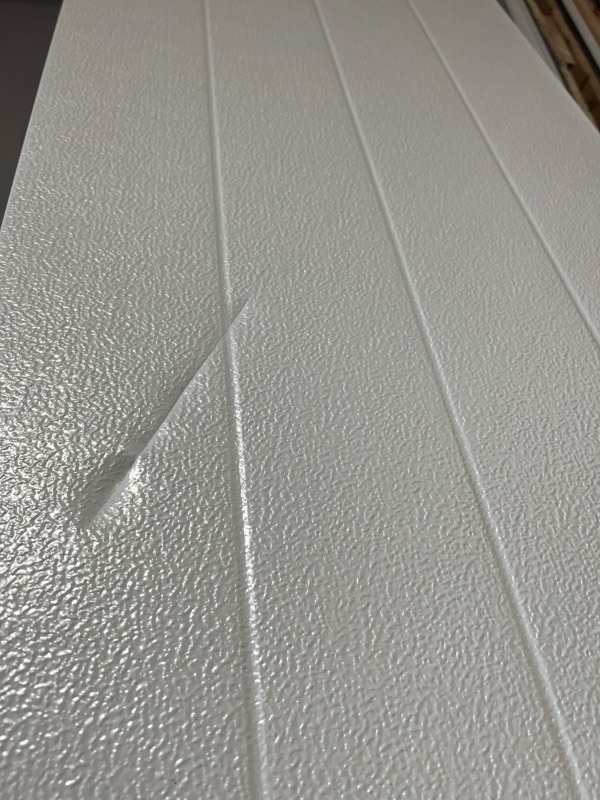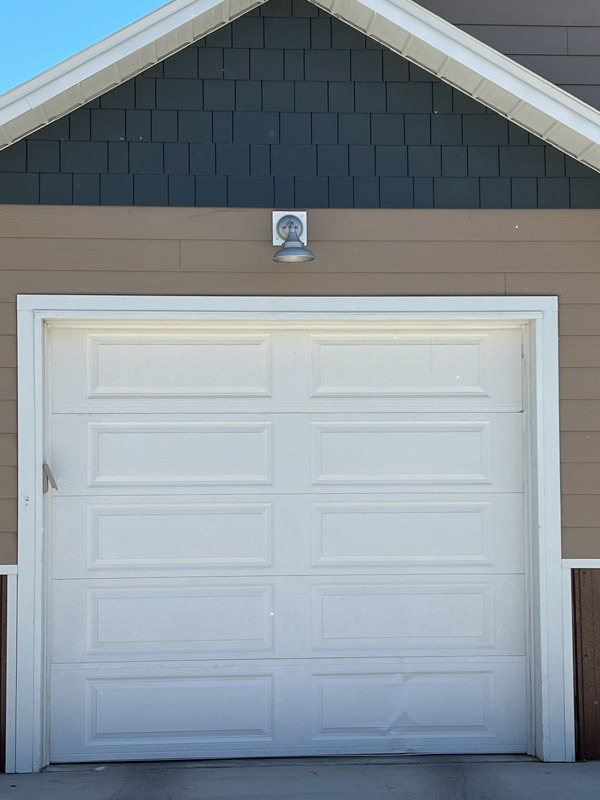
We are going to discuss repairing dents in metal garage door panels in this article. These are the most common panels that make our garage doors of today – and older models, and others, can be made with other materials to be sure. The other materials tend to break, versus get dented.
In addressing how to repair a dented garage door we first have to identify the type of garage door panels we are working on. Then we can determine if we have a dent with a functional problem or if it’s aesthetics and affecting looks only.
In this article, we’ll outline the two types of panels – insulated (sandwich steel) or non-insulated (pan door) and then discuss the aesthetic dent and the functional dent repair options.
The two types of panels include the insulated, or sandwich steel panel and the non-insulated, or pan door.
Sandwich steel panels are constructed with two pieces of sheet metal. A front piece is forming the outside of the door and the back piece forms the inside. These two pieces are then sandwiched together insulated in the middle. Insulation is more often a polyurethane or the blown in style of insulation which also adheres to the metals – this forms a strong panel that is essentially glued together as the insulation cures into place.
Side note: if you’re shopping for insulated panels, be sure to ask about the ‘true thermal break.’ If you’re buying insulation, this is an important consideration to make sure these two pieces of metal are not touching one another – thus stopping and heat or cold transfer to your garage interior.
Pan doors are constructed of one piece of sheet metal only. The metal is formed into the garage door panel and can be installed as a true open back panel or a styrofoam style insulation can be stuffed inside the cavity of the panel. There is no thermal break on pan doors and they tend to be the economic workhorse of the garage door lines.

In addressing dents that can occur, let’s define an aesthetic dent versus a functionally disruptive dent.
Aesthetic dents are dents that can affect looks. Perhaps it’s a crease along a panel created from a vehicle pushing it beyond the flex point. Or it’s a dent in the middle of the design created by an impact of a ball or bicycle. Aesthetic dents can be a bummer as they take away from curb appeal and they may remind you every time you see them of the incident that occurred. However, they don’t disrupt function. There is not additional strain on the operation of the door. You may in fact have been living with the dent(s) already for some time now. And below we may be able to offer some solutions to fixing this – but its looks only.
A functional dent impacts the door’s operations. These dents put additional friction and strain on the operating systems and if these are left unaddressed, more problems will occur.
So how do we repair a dented garage door?
For aesthetic dents on pan doors – you can find the pressure points from the opposite side of your dent and apply pressure to push them out and back into place. This takes some finesse and ‘art’ to get dialed in. And much of the aesthetics can be regained with this subtle body work.
For function moves on pan doors – adding pressure to the panel from the opposite side of where the dent occurred may offer short term solution and some functionality. And like you’ll read below, it is best to review function with a trained professional and panel replacement may be the best overall solution.
In general, pan doors offer some flexibility in repairing a dented garage door as we can access both sides and push and pull metal materials into place again.
Sandwich steel doors are a little less limited when it comes to repairing dents. We don’t have access to the other side of the front metal piece as this is blocked by insulation and the back metal piece. For aesthetic dents on sandwich steel doors – if they are near the very edge of the panel, you may be able to gain access through the side of the panel with a flat screwdriver to push out metal. However, when we begin moving metal this can cause a break in the insulation bond – and thus a delamination. While this can still be aesthetic primarily, we’re now impacting the panel integrity and strength – along with creating cavity space which reduces insulation properties.
On interior dents that are aesthetic, a sticker can be replaced like shown here. https://www.instagram.com/reel/C7epQjkByOj/?utm_source=ig_web_copy_link&igsh=MzRlODBiNWFlZA==
Sandwich steel doors that are hit and bent to disrupt functionality need to be replaced. Again some short term pushing to get into place may offer some short term functionality. But this will have consequences overtime and a professional should be called to get a replacement moving.
In full transparency, it’s difficult to repair a dented garage door. Some tricks can be used to push and pull dents out and as a homeowner, exploring the function of your garage door is the critical thing to determine as this can add costs overtime if function is impacted.
At any time it’s important to get a trusted professional onsite to consult with you in determining best steps. For most garage door models, a panel replacement is not incredibly expensive and is often the best route to maintain your garage door integrity and smooth functionality for the long term. And it’s more pleasing to look at.